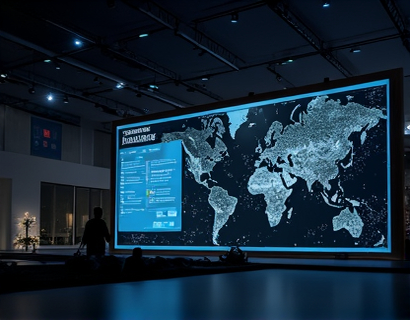Next-Gen QR Code Technology: Elevating Business Engagement and Social Media Interaction for Modern Enterprises
In the rapidly evolving digital landscape, businesses and social media managers are constantly seeking innovative solutions to enhance engagement and interaction. One such technology that has emerged as a game-changer is next-generation QR code technology. This advanced form of QR codes is not just an improvement over the traditional version but a complete reimagining designed to meet the complex needs of modern enterprises. These next-gen QR codes offer customizable and intuitive tools that streamline information sharing and significantly boost customer interaction, making them essential for brands looking to enhance their digital presence and foster deeper connections with their audience.
The evolution of QR codes from simple static images to dynamic, interactive tools reflects the broader trends in digital technology. Traditional QR codes were primarily used for basic tasks like directing users to websites or providing product information. However, next-gen QR codes go far beyond these limitations. They are designed to handle a wide range of data types, including text, URLs, images, videos, and even complex datasets. This versatility makes them an invaluable asset for businesses aiming to create rich, immersive experiences for their customers.
One of the key features of next-gen QR codes is their customizability. Unlike standard QR codes, which have a fixed appearance and limited functionality, next-gen QR codes can be tailored to fit specific brand identities and marketing strategies. Businesses can choose from a variety of colors, shapes, and sizes, allowing the QR code to seamlessly integrate into their visual branding. This level of customization not only enhances the aesthetic appeal but also ensures that the QR code stands out, increasing the likelihood of user interaction.
Another significant advantage of next-gen QR codes is their ability to provide real-time updates and dynamic content. Traditional QR codes once scanned, lead to a static URL that does not change. In contrast, next-gen QR codes can be linked to content management systems, enabling businesses to update the linked information without the need to reprint the QR code. This dynamic capability is particularly useful for promoting time-sensitive offers, sharing live event updates, or providing the latest product information. It ensures that the content remains fresh and relevant, keeping customers engaged and informed.
The integration of next-gen QR codes with digital platforms and social media is another area where they excel. Social media managers can use these QR codes to drive traffic to their profiles, share behind-the-scenes content, or create interactive campaigns. For instance, a QR code placed in a physical advertisement can direct users to a special social media challenge or a live Q&A session with a brand ambassador. This seamless transition between offline and online spaces enhances the overall customer experience and encourages more meaningful interactions.
Moreover, next-gen QR codes are designed with user experience in mind. They are faster to scan than traditional QR codes, reducing the friction that often deters users from engaging with them. The advanced error correction technology ensures that even if the code is partially damaged, it can still be read accurately. This reliability is crucial in environments where QR codes are exposed to various conditions, such as outdoor advertising or busy retail spaces.
The data analytics capabilities of next-gen QR codes are another significant benefit. Unlike static QR codes, these advanced codes can track scans and provide detailed insights into user behavior. Businesses can monitor how many times a QR code is scanned, where it is being used, and what actions users take after scanning. This data is invaluable for refining marketing strategies, optimizing content, and measuring the effectiveness of engagement initiatives. By leveraging these insights, businesses can make data-driven decisions to enhance their overall digital strategy.
In the realm of customer service, next-gen QR codes offer innovative solutions. For example, a QR code can be used to provide instant access to customer support resources, such as FAQs, tutorials, or live chat options. This immediate access to information not only improves customer satisfaction but also reduces the workload on support teams. Additionally, QR codes can be used to collect customer feedback directly at the point of interaction, providing businesses with real-time insights into customer preferences and pain points.
The application of next-gen QR codes extends beyond marketing and customer service. In the retail sector, these codes can enhance the in-store experience by linking to product details, customer reviews, and special offers. In the healthcare industry, QR codes can be used to provide patients with access to their medical records, appointment schedules, and health tips. In the educational sector, QR codes can link to interactive learning materials, virtual labs, and additional reading resources. The versatility of next-gen QR codes makes them applicable across various industries, each benefiting from the unique features and capabilities they offer.
From a technical standpoint, the creation and implementation of next-gen QR codes involve advanced algorithms and encoding techniques. These codes use a combination of matrix barcodes and digital watermarking to store and transmit data efficiently. The use of multiple layers and error correction codes ensures high data density and robustness. This technological foundation allows for the creation of QR codes that are not only visually appealing but also highly functional and secure.
The adoption of next-gen QR codes also aligns with the growing trend of omnichannel marketing. By providing a seamless bridge between physical and digital touchpoints, businesses can create a cohesive and integrated customer journey. For example, a customer might scan a QR code in a store to learn more about a product, then be directed to a personalized landing page on the company’s website, where they can watch a video review, read customer testimonials, and make a purchase. This omnichannel approach ensures that the customer experience is consistent and engaging, regardless of the platform.
Furthermore, next-gen QR codes support the growing demand for mobile-first strategies. With the majority of internet users accessing content through mobile devices, QR codes that are optimized for mobile scanning are essential. These codes are designed to be quickly and easily read by smartphone cameras, ensuring a smooth and efficient user experience. This mobile compatibility is crucial for businesses aiming to reach a tech-savvy audience that expects instant access to information and interactive content.
The environmental impact of next-gen QR codes should also be considered. By reducing the need for printed materials and providing digital alternatives, these codes help businesses minimize their carbon footprint. Digital information sharing through QR codes reduces paper waste and the resources required for printing and distribution. This eco-friendly approach resonates with consumers who are increasingly conscious of their environmental impact, further enhancing the brand’s reputation and appeal.
In conclusion, next-gen QR code technology represents a significant advancement in digital engagement tools for modern enterprises. Their customizability, dynamic content capabilities, seamless integration with digital platforms, and robust data analytics make them an indispensable asset for businesses looking to enhance their online and offline presence. By adopting these advanced QR codes, companies can create more engaging, interactive, and personalized experiences for their customers, ultimately driving higher levels of engagement and loyalty.










































